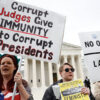A young, African American male would have had a better chance of survival descending from a landing barge in Italy during WWII than he does getting off a Greyhound bus in a major U.S. city today. This according to Bob Woodson, president of the Center for Neighborhood Enterprise, which has created Violence Free Zones that are having dramatic effect turning around some of the most dangerous cities across the country. These Violence Free Zones (VFZ) have changed the lives of children, many of whom were involved with gang activity, sold drugs, and pushed their education to the back-burner prior to encountering VFZ
Yesterday, in a summit on youth violence held in Washington, D.C., Woodson and his team of youth mentors explained what makes their approach so effective, and what differentiates them from other programs. The Center for Neighborhood Enterprise partners with community-based organizations – groups that are already well-established in a community and know the local players – and then provides those organizations with the information they need to stamp out the violence plaguing their neighborhoods. Woodson notes:
These natural community leaders are like antibodies developed by the body itself. They operate in different cultural zip codes than the professional educational establishment. Trusted by the students, they offer a source of emotional support. They act as moral mentors and character coaches, and they are role models that prove that no matter how dysfunctional the environment, it is possible to succeed.
Student mentors in many cases act as de-facto family members, and as such, must be available 24/7. Much of the success of the Violence Free Zone initiative is achieved because mentors are still available to students on the weekends. If a student finds himself in trouble on a Saturday night, that trouble is likely to follow them to school Monday morning, as school administrators at the conference attested to. Having their mentor available every day, all day, helps to diffuse these situations outside of the school environment.
And the Violence Free Zones have demonstrably improved
student outcomes. According to researchers at Baylor University, six high schools in Milwaukee that had implemented the Violence Free Zone program saw GPAs rise, suspensions decline and violent incidents diminish as a result. In Richmond, Virginia, there was a 60 percent reduction in car thefts near the schools that have incorporated Violence Free Zones.
Solutions to youth violence have stayed “drearily the same,” said Clarence Page, a Pulitzer-Prize winning columnist for the Chicago Tribune who moderated the summit. They’re akin to watching 5-year-olds play soccer. Everyone follows the ball. But unlike these programs, Woodson’s Center for Neighborhood Enterprise’s efforts have expanded to 39 states, with Violence Free Zones operating in major urban centers such as Baltimore, Atlanta, and Dallas.
While experts and authorities presented–including researchers Byron Johnson and William Wubbenhorst of Baylor University and Milwaukee Public Schools Superintendent William G. Andrekopoulos–the most compelling testimonials were provided by the students whose lives have been transformed by Woodson’s model. Students who had been to jail or prison on multiple occasions spoke about the transformative effect the VFZ had on their lives. The “transactional mentors”– former troubled youths themselves, are now passing on what changed them. And the centerpiece of that transaction is trust.



























